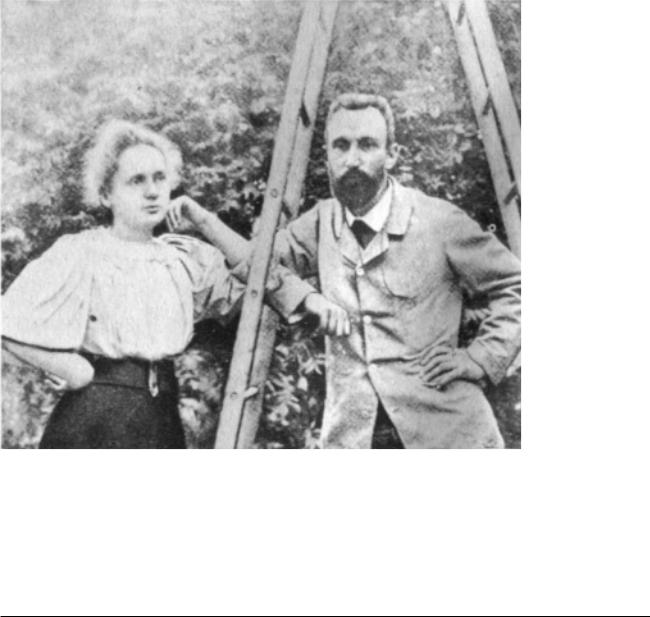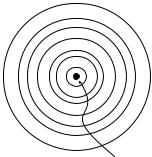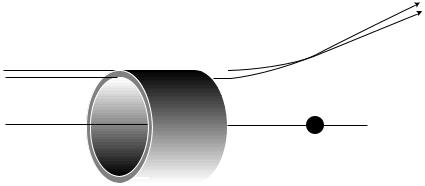
B.Crowell - Electricity and Magnetism, Vol
.4.pdf
Marie and Pierre Curie were the first to purify radium in significant quantities. Radium’s intense radioactivity made possible the experiments that led to the modern planetary model of the atom, in which electrons orbit a nucleus made of protons and neutrons.
2 The Nucleus
2.1Radioactivity
Becquerel’s discovery of radioactivity
How did physicists figure out that the raisin cookie model was incorrect, and that the atom’s positive charge was concentrated in a tiny, central nucleus? The story begins with the discovery of radioactivity by the French chemist Becquerel. Up until radioactivity was discovered, all the processes of nature were thought to be based on chemical reactions, which were rearrangements of combinations of atoms. Atoms exert forces on each other when they are close together, so sticking or unsticking them would either release or store potential energy. That energy could be converted to and from other forms, as when a plant uses the energy in sunlight to make sugars and carbohydrates, or when a small child eats sugar, releasing the energy in the form of kinetic energy.
Becquerel discovered a process that seemed to release energy from an unknown new source that was not chemical. Becquerel, whose father and grandfather had also been physicists, spent the first twenty years of his
Section 2.1 Radioactivity |
41 |
professional life as a successful civil engineer, teaching physics only on a part-time basis. He was awarded the chair of physics at the Musée d’Histoire Naturelle in Paris after the death of his father, who had previously occupied it. Having now a significant amount of time to devote to physics, he began studying the interaction of light and matter. He became interested in the phenomenon of phosphorescence, in which a substance absorbs energy from light, then releases the energy via a glow that only gradually goes away. One of the substances he investigated was a uranium compound, the salt UKSO5. One day in 1896, cloudy weather interfered with his plan to expose this substance to sunlight in order to observe its fluorescence. He stuck it in a drawer, coincidentally on top of a blank photographic plate — the old-fashioned glass-backed counterpart of the modern plastic roll of film. The plate had been carefully wrapped, but several days later when Becquerel checked it in the darkroom before using it, he found that it was ruined, as if it had been completely exposed to light.
History provides many examples of scientific discoveries that occurred in this way: an alert and inquisitive mind decides to investigate a phenomenon that most people would not have worried about explaining. He first determined by further experiments that the effect was produced by the uranium salt, despite a thick wrapping of paper around the plate that blocked out all light. He tried a variety of compounds, and found that it was the uranium that did it: the effect was produced by any uranium compound, but not by any compound that didn’t include uranium atoms. The effect could be at least partially blocked by a sufficient thickness of metal, and he was able to produce silhouettes of coins by interposing them between the uranium and the plate. This indicated that the effect traveled in a straight line., so that it must have been some kind of ray rather than, e.g., the seepage of chemicals through the paper. He used the word “radiations,” since the effect radiated out from the uranium salt.
At this point Becquerel still believed that the uranium atoms were absorbing energy from light and then gradually releasing the energy in the form of the mysterious rays, and this was how he presented it in his first published lecture describing his experiments. Interesting, but not earthshattering. But he then tried to determine how long it took for the uranium to use up all the energy that had supposedly been stored in it by light, and he found that it never seemed to become inactive, no matter how long he waited. Not only that, but a sample that had been exposed to intense sunlight for a whole afternoon was no more or less effective than a sample that had always been kept inside. Was this a violation of conservation of energy? If the energy didn’t come from exposure to light, where did it come from?
42 |
Chapter 2 The Nucleus |
Three kinds of “radiations”
Unable to determine the source of the energy directly, turn-of-the- century physicists instead studied the behavior of the “radiations” once they had been emitted. Becquerel had already shown that the radioactivity could penetrate through cloth and paper, so the first obvious thing to do was to investigate in more detail what thickness of material the radioactivity could get through. They soon learned that a certain fraction of the radioactivity’s intensity would be eliminated by even a few inches of air, but the remainder was not eliminated by passing through more air. Apparently, then, the radioactivity was a mixture of more than one type, of which one was blocked by air. They then found that of the part that could penetrate air, a further fraction could be eliminated by a piece of paper or a very thin metal foil. What was left after that, however, was a third, extremely penetrating type, some of whose intensity would still remain even after passing through a brick wall. They decided that this showed there were three types of radioactivity, and without having the faintest idea of what they really were, they made up names for them. The least penetrating type was arbitrarily labeled α (alpha), the first letter of the Greek alphabet, and so on through β (beta) and finally γ (gamma) for the most penetrating type.
Radium: a more intense source of radioactivity
The measuring devices used to detect radioactivity were crude: photographic plates or even human eyeballs (radioactivity makes flashes of light in the jelly-like fluid inside the eye, which can be seen by the eyeball’s owner if it is otherwise very dark). Because the ways of detecting radioactivity were so crude and insensitive, further progress was hindered by the fact that the amount of radioactivity emitted by uranium was not really very great. The vital contribution of physicist/chemist Marie Curie and her husband Pierre was to discover the element radium, and to purify and isolate significant quantities of it. Radium emits about a million times more radioactivity per unit mass than uranium, making it possible to do the experiments that were needed to learn the true nature of radioactivity. The dangers of radioactivity to human health were then unknown, and Marie died of leukemia thirty years later. (Pierre was run over and killed by a horsecart.)
Section 2.1 Radioactivity |
43 |

alpha particles
thin glass wall
radon gas
A simplified version of Rutherford’s 1908 experiment, showing that alpha particles were doubly ionized helium atoms.
Tracking down the nature of alphas, betas, and gammas
As radium was becoming available, an apprentice scientist named Ernest Rutherford arrived in England from his native New Zealand and began studying radioactivity at the Cavendish Laboratory. The young colonial’s first success was to measure the mass-to-charge ratio of beta rays. The technique was essentially the same as the one Thomson had used to measure the mass-to-charge ratio of cathode rays by measuring their deflections in electric and magnetic fields. The only difference was that instead of the cathode of a vacuum tube, a nugget of radium was used to supply the beta rays. Not only was the technique the same, but so was the result. Beta rays had the same m/q ratio as cathode rays, which suggested they were one and the same. Nowadays, it would make sense simply to use the term “electron,” and avoid the archaic “cathode ray” and “beta particle,” but the old labels are still widely used, and it is unfortunately necessary for physics students to memorize all three names for the same thing.
At first, it seemed that neither alphas or gammas could be deflected in electric or magnetic fields, making it appear that neither was electrically charged. But soon Rutherford obtained a much more powerful magnet, and was able to use it to deflect the alphas but not the gammas. The alphas had a much larger value of m/q than the betas (about 4000 times greater), which was why they had been so hard to deflect. Gammas are uncharged, and were later found to be a form of light.
The m/q ratio of alpha particles turned out to be the same as those of two different types of ions, He++ (a helium atom with two missing electrons) and H2+ (two hydrogen atoms bonded into a molecule, with one electron missing) , so it seemed likely that they were one or the other of those. The diagram shows a simplified version of Rutherford’s ingenious experiment proving that they were He++ ions. The gaseous element radon, an alpha emitter, was introduced into one half of a double glass chamber. The glass wall dividing the chamber was made extremely thin, so that some of the rapidly moving alpha particles were able to penetrate it. The other chamber, which was initially evacuated, gradually began to accumulate a population of alpha particles (which would quickly pick up electrons from their surroundings and become electrically neutral). Rutherford then determined that it was helium gas that had appeared in the second chamber. Thus alpha particles were proved to be He++ ions. The nucleus was yet to be discovered, but in modern terms, we would describe a He++ ion as the nucleus of a He atom.
To summarize, here are the three types of radiation emitted by radioactive elements, and their descriptions in modern terms:
alpha particle |
stopped by a few inches of air |
He nucleus |
beta particle |
stopped by a piece of paper |
electron |
gamma ray |
penetrates thick shielding |
a type of light |
Discussion Question
Most sources of radioactivity emit alphas, betas, and gammas, not just one of the three. In the radon experiment, how did Rutherford know that he was studying the alphas?
44 |
|
|
|
|
|
|
|
|
|
|
|
|
|
|
|
|
|
|
|
|
|
|
|
|
|
|
|
|
|
Chapter 2 The Nucleus |
|||||

2.2The Planetary Model of the Atom
radium
vacuum chamber
alpha particles
gold foil
scintillating screen
microscope
The stage was now set for the unexpected discovery that the positively charged part of the atom was a tiny, dense lump at the atom’s center rather than the “cookie dough” of the raisin cookie model. By 1909, Rutherford was an established professor, and had students working under him. For a raw undergraduate named Marsden, he picked a research project he thought would be tedious but straightforward.
It was already known that although alpha particles would be stopped completely by a sheet of paper, they could pass through a sufficiently thin metal foil. Marsden was to work with a gold foil only 1000 atoms thick.
(The foil was probably made by evaporating a little gold in a vacuum chamber so that a thin layer would be deposited on a glass microscope slide. The foil would then be lifted off the slide by submerging the slide in water.)
Rutherford had already determined in his previous experiments the speed of the alpha particles emitted by radium, a fantastic 1.5x107 m/s. The experimenters in Rutherford’s group visualized them as very small, very fast cannonballs penetrating the “cookie dough” part of the big gold atoms. A piece of paper has a thickness of a hundred thousand atoms or so, which would be sufficient to stop them completely, but crashing through a thousand would only slow them a little and turn them slightly off of their original paths.
Marsden’s supposedly ho-hum assignment was to use the apparatus shown in the figure to measure how often alpha particles were deflected at various angles. A tiny lump of radium in a box emitted alpha particles, and a thin beam was created by blocking all the alphas except those that happened to pass out through a tube. Typically deflected in the gold by only a small amount, they would reach a screen very much like the screen of a TV’s picture tube, which would make a flash of light when it was hit. Here is the first example we have encountered of an experiment in which a beam of particles is detected one at a time. This was possible because each alpha particle carried so much kinetic energy; they were moving at about the same speed as the electrons in the Thomson experiment, but had ten thousand times more mass.
Marsden sat in a dark room, watching the apparatus hour after hour and recording the number of flashes with the screen moved to various angles. The rate of the flashes was highest when he set the screen at an angle close to the line of the alphas’ original path, but if he watched an area farther off to the side, he would also occasionally see an alpha that had been deflected through a larger angle. After seeing a few of these, he got the crazy idea of moving the screen to see if even larger angles ever occurred, perhaps even angles larger than 90 degrees.
The crazy idea worked: a few alpha particles were deflected through angles of up to 180 degrees, and the routine experiment had become an epoch-making one. Rutherford said, “We have been able to get some of the alpha particles coming backwards. It was almost as incredible as if you fired a 15-inch shell at a piece of tissue paper and it came back and hit you.” Explanations were hard to come by in the raisin cookie model. What
Section 2.2 The Planetary Model of the Atom |
45 |

orbiting electrons
nucleus
The planetary model of the atom.
intense electrical forces could have caused some of the alpha particles, moving at such astronomical speeds, to change direction so drastically? Since each gold atom was electrically neutral, it would not exert much force on an alpha particle outside it. True, if the alpha particle was very near to or inside of a particular atom, then the forces would not necessarily cancel out perfectly; if the alpha particle happened to come very close to a particular electron, the 1/r2 form of the Coulomb force law would make for a very strong force. But Marsden and Rutherford knew that an alpha particle was 8000 times more massive than an electron, and it is simply not possible for a more massive object to rebound backwards from a collision with a less massive object while conserving momentum and energy. It might be possible in principle for a particular alpha to follow a path that took it very close to one electron, and then very close to another electron, and so on, with the net result of a large deflection, but careful calculations showed that such multiple “close encounters” with electrons would be millions of times too rare to explain what was actually observed.
At this point, Rutherford and Marsden dusted off an unpopular and neglected model of the atom, in which all the electrons orbited around a small, positively charged core or “nucleus,” just like the planets orbiting around the sun. All the positive charge and nearly all the mass of the atom would be concentrated in the nucleus, rather than spread throughout the atom as in the raisin cookie model. The positively charged alpha particles would be repelled by the gold atom’s nucleus, but most of the alphas would not come close enough to any nucleus to have their paths drastically altered. The few that did come close to a nucleus, however, could rebound backwards from a single such encounter, since the nucleus of a heavy gold atom would be fifty times more massive than an alpha particle. It turned out that it was not even too difficult to derive a formula giving the relative frequency of deflections through various angles, and this calculation agreed with the data well enough (to within 15%), considering the difficulty in getting good experimental statistics on the rare, very large angles.
What had started out as a tedious exercise to get a student started in science had ended as a revolution in our understanding of nature. Indeed, the whole thing may sound a little too much like a moralistic fable of the scientific method with overtones of the Horatio Alger genre. The skeptical reader may wonder why the planetary model was ignored so thoroughly until Marsden and Rutherford’s discovery. Is science really more of a sociological enterprise, in which certain ideas become accepted by the establishment, and other, equally plausible explanations are arbitrarily discarded? Some social scientists are currently ruffling a lot of scientists’ feathers with critiques very much like this, but in this particular case, there were very sound reasons for rejecting the planetary model. As you’ll learn in more detail later in this course, any charged particle that undergoes an acceleration dissipates energy in the form of light. In the planetary model, the electrons were orbiting the nucleus in circles or ellipses, which meant
46 |
Chapter 2 The Nucleus |

A nonmetal.
A nonmagnetic metal.
A magnetized metal.
Note that all these figures are simplified in several ways. For one thing, the electrons of an individual atom do not all revolve around the nucleus in the same plane. It is also very unusual for a metal to become so strongly magnetized that 100% of its atoms have their rotations aligned as shown in this figure.
they were undergoing acceleration, just like the acceleration you feel in a car going around a curve. They should have dissipated energy as light, and eventually they should have lost all their energy. Atoms don’t spontaneously collapse like that, which was why the raisin cookie model, with its stationary electrons, was originally preferred. There were other problems as well. In the planetary model, the one-electron atom would have to be flat, which would be inconsistent with the success of molecular modeling with spherical balls representing hydrogen and atoms. These molecular models also seemed to work best if specific sizes were used for different atoms, but there is no obvious reason in the planetary model why the radius of an electron’s orbit should be a fixed number. In view of the conclusive Marsden-Ruther- ford results, however, these became fresh puzzles in atomic physics, not reasons for disbelieving the planetary model.
Some phenomena explained with the planetary model
The planetary model may not be the ultimate, perfect model of the atom, but don’t underestimate its power. It already allows us to visualize correctly a great many phenomena.
As an example, let’s consider the distinctions among nonmetals, metals that are magnetic, and metals that are nonmagnetic. As shown in the figures, a metal differs from a nonmetal because its outermost electrons are free to wander rather than owing their allegiance to a particular atom. A metal that can be magnetized is one that is willing to line up the rotations of some of its electrons so that their axes are parallel. Recall that magnetic forces are forces made by moving charges; we have not yet discussed the mathematics and geometry of magnetic forces, but it is easy to see how random orientations of the atoms in the nonmagnetic substance would lead to cancellation of the forces.
Even if the planetary model does not immediately answer such questions as why one element would be a metal and another a nonmetal, these ideas would be difficult or impossible to conceptualize in the raisin cookie model.
Discussion questions
In reality, charges of the same type repel one another and charges of different types are attracted. Suppose the rules were the other way around, giving repulsion between opposite charges and attraction between similar ones. What would the universe be like?
Section 2.2 The Planetary Model of the Atom |
47 |

2.3 Atomic Number
As alluded to in a discussion question in the previous section, scientists of this period had only a very approximate idea of how many units of charge resided in the nuclei of the various chemical elements. Although we now associate the number of units of nuclear charge with the element’s position on the periodic table, and call it the atomic number, they had no idea that such a relationship existed. Mendeleev’s table just seemed like an organizational tool, not something with any necessary physical significance. And everything Mendeleev had done seemed equally valid if you turned the table upside-down or reversed its left and right sides, so even if you wanted to number the elements sequentially with integers, there was an ambiguity as to how to do it. Mendeleev’s original table was in fact upside-down compared to the modern one.
In the period immediately following the discovery of the nucleus, physicists only had rough estimates of the charges of the various nuclei. In the case of the very lightest nuclei, they simply found the maximum number of electrons they could strip off by various methods: chemical reactions, electric sparks, ultraviolet light, and so on. For example they could easily strip off one or two electrons from helium, making He+ or He++, but nobody could make He+++, presumably because the nuclear charge of helium was only +2e. Unfortunately only a few of the lightest elements could be stripped completely, because the more electrons were stripped off, the greater the positive net charge remaining, and the more strongly the rest of the negatively charged electrons would be held on. The heavy elements’ atomic numbers could only be roughly extrapolated from the light elements, where the atomic number was about half the atom’s mass expressed in units of the mass of a hydrogen atom. Gold, for example, had a mass about 197 times that of hydrogen, so its atomic number was estimated to be about half that, or somewhere around 100. We now know it to be 79.
How did we finally find out? The riddle of the nuclear charges was at last successfully attacked using two different techniques, which gave consis-
1 |
|
|
|
|
|
|
|
|
|
|
|
|
|
|
|
|
|
|
|
|
|
|
|
|
|
|
|
|
|
|
|
|
2 |
H |
|
|
|
|
|
|
|
|
|
|
|
|
|
|
|
|
|
|
|
|
|
|
|
|
|
|
|
|
|
|
|
|
He |
3 |
4 |
|
|
|
|
|
|
|
|
|
|
|
|
|
|
|
|
|
|
|
|
|
5 |
6 |
7 |
8 |
9 |
10 |
|||||
Li |
Be |
|
|
|
|
|
|
|
|
|
|
|
|
|
|
|
|
|
|
|
|
|
|
B |
|
C |
|
N |
|
O |
|
F |
Ne |
11 |
12 |
|
|
|
|
|
|
|
|
|
|
|
|
|
|
|
|
|
|
|
|
|
13 |
14 |
15 |
16 |
17 |
18 |
|||||
Na |
Mg |
|
|
|
|
|
|
|
|
|
|
|
|
|
|
|
|
|
|
|
|
|
|
Al |
|
Si |
|
P |
|
S |
|
Cl |
Ar |
19 |
20 |
21 |
|
22 |
23 |
24 |
25 |
26 |
27 |
28 |
29 |
30 |
31 |
32 |
33 |
34 |
35 |
36 |
|||||||||||||||
K |
Ca |
Sc |
|
|
Ti |
|
V |
|
Cr |
|
Mn |
|
Fe |
|
Co |
|
Ni |
|
Cu |
|
Zn |
|
Ga |
|
Ge |
|
As |
|
Se |
|
Br |
Kr |
|
37 |
38 |
39 |
|
40 |
41 |
42 |
43 |
44 |
45 |
46 |
47 |
48 |
49 |
50 |
51 |
52 |
53 |
54 |
|||||||||||||||
Rb |
Sr |
Y |
|
|
Zr |
|
Nb |
Mo |
|
Tc |
|
Ru |
|
Rh |
|
Pd |
|
Ag |
|
Cd |
|
In |
|
Sn |
|
Sb |
|
Te |
|
I |
Xe |
||
55 |
56 |
57 |
|
72 |
73 |
74 |
75 |
76 |
77 |
78 |
79 |
80 |
81 |
82 |
83 |
84 |
85 |
86 |
|||||||||||||||
Cs |
Ba |
La |
* |
|
Hf |
|
Ta |
|
W |
|
Re |
|
Os |
|
Ir |
|
Pt |
|
Au |
|
Hg |
|
Tl |
|
Pb |
|
Bi |
|
Po |
|
At |
Rn |
|
87 |
88 |
89 |
|
104 |
105 |
106 |
107 |
108 |
109 |
110 |
111 |
112 |
113 |
114 |
115 |
116 |
117 |
118 |
|||||||||||||||
Fr |
Ra |
Ac |
** |
|
Rf |
|
Ha |
|
|
|
|
|
|
|
|
|
|
|
|
|
|
|
|
|
|
|
|
|
|
|
|
|
|
|
|
|
|
|
|
|
|
|
|
|
|
|
|
|
|
|
|
|
|
|
|
|
|
|
|
|
|
|
|
|
|
|
|
|
|
|
58 |
|
59 |
|
60 |
|
61 |
|
62 |
|
63 |
|
64 |
|
65 |
|
66 |
|
67 |
|
68 |
|
69 |
|
70 |
|
71 |
|
|
|
|
|
|
* |
Ce |
Pr |
|
Nd |
Pm |
Sm |
Eu |
Gd |
Tb |
|
Dy |
|
Ho |
Er |
|
Tm |
Yb |
Lu |
|
|
|
||||||||||
|
|
** |
Th |
|
Pa |
|
U |
|
Np |
Pu |
|
Am |
Cm |
Bk |
|
Cf |
|
Es |
|
Fm |
Md |
No |
Lr |
|
|
|
|||||||
A modern periodic table, labeled with atomic numbers. Mendeleev’s original table was upside-down compared to this one.
48 |
Chapter 2 The Nucleus |

tent results. One set of experiments, involving x-rays, was performed by the young Henry Mosely, whose scientific brilliance was soon to be sacrificed in a battle between European imperialists over who would own the Dardanelles, during that pointless conflict then known as the War to End All Wars, and now referred to as World War I.
Since Mosely’s analysis requires several concepts with which you are not yet familiar, we will instead describe the technique used by James Chadwick at around the same time. An added bonus of describing Chadwick’s experiments is that they presaged the important modern technique of studying collisions of subatomic particles. In grad school, I worked with a professor whose thesis adviser’s thesis adviser was Chadwick, and he related some interesting stories about the man. Chadwick was apparently a little nutty and a complete fanatic about science, to the extent that when he was held in a German prison camp during World War II, he managed to cajole his captors into allowing him to scrounge up parts from broken radios so that he could attempt to do physics experiments.
Chadwick’s experiment worked like this. Suppose you perform two Rutherford-type alpha scattering measurements, first one with a gold foil as a target as in Rutherford’s original experiment, and then one with a copper foil. It is possible to get large angles of deflection in both cases, but as shown in the figure, the alpha particle must be heading almost straight for the copper nucleus to get the same angle of deflection that would have occurred with an alpha that was much farther off the mark; the gold nucleus’ charge is so much greater than the copper’s that it exerts a strong force on the alpha particle even from far off. The situation is very much like that of a blindfolded person playing darts. Just as it is impossible to aim an alpha particle at an individual nucleus in the target, the blindfolded person cannot really aim the darts. Achieving a very close encounter with the copper atom would be akin to hitting an inner circle on the dartboard. It’s
alpha particle
copper nucleus
alpha particle
gold nucleus
Section 2.3 Atomic Number |
49 |

20°
19°
nucleus
An alpha particle must be headed for the ring on the front of the imaginary cylindrical pipe in order to produce scattering at an angle between 19 and 20 degrees. The area of this ring is called the "crosssection" for scattering at 19-20° because it is the cross-sectional area of a cut through the pipe.
much more likely that one would have the luck to hit the outer circle, which covers a greater number of square inches. By analogy, if you measure the frequency with which alphas are scattered by copper at some particular angle, say between 19 and 20 degrees, and then perform the same measurement at the same angle with gold, you get a much higher percentage for gold than for copper.
In fact, the numerical ratio of the two nuclei’s charges can be derived from this same experimentally determined ratio. Using the standard notation Z for the atomic number (charge of the nucleus divided by e), the following equation can be proved:
Z gold2 |
= |
number of alphas scattered by gold at 19–20° |
||
2 |
|
number of alphas scattered by copper at 19–20° |
|
|
Z copper |
|
|
|
|
By making such measurements for targets constructed from all the elements, one can infer the ratios of all the atomic numbers, and since the atomic numbers of the light elements were already known, atomic numbers could be assigned to the entire periodic table. According to Mosely, the atomic numbers of copper, silver and platinum were 29, 47, and 78, which corresponded well with their positions on the periodic table. Chadwick’s figures for the same elements were 29.3, 46.3, and 77.4, with error bars of about ± 1.5 times the fundamental charge, so the two experiments were in good agreement.
The point here is absolutely not that you should be ready to plug numbers into the above equation for a homework or exam question! My overall goal in this chapter is to explain how we know what we know about atoms. An added bonus of describing Chadwick’s experiment is that the approach is very similar to that used in modern particle physics experiments, and the ideas used in the analysis are closely related to the nowubiquitous concept of a “cross-section.” In the dartboard analogy, the crosssection would be the area of the circular ring you have to hit. The reasoning behind the invention of the term “cross-section” can be visualized as shown in the figure. In this language, Rutherford’s invention of the planetary model came from his unexpected discovery that there was a nonzero crosssection for alpha scattering from gold at large angles, and Chadwick confirmed Mosely’s determinations of the atomic numbers by measuring cross-sections for alpha scattering.
50 |
Chapter 2 The Nucleus |
